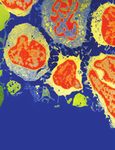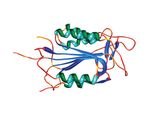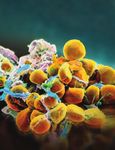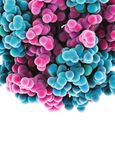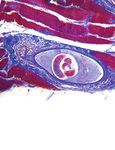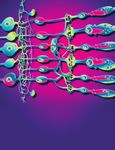Case Report Pantoea agglomerans Infections in Children: Report of Two Cases
←
→
Page content transcription
If your browser does not render page correctly, please read the page content below
Hindawi
Case Reports in Pediatrics
Volume 2018, Article ID 4158734, 3 pages
https://doi.org/10.1155/2018/4158734
Case Report
Pantoea agglomerans Infections in Children: Report of
Two Cases
Shraddha Siwakoti ,1 Rinku Sah,1 Rupa Singh Rajbhandari,2 and Basudha Khanal1
1
Department of Microbiology, B.P. Koirala Institute of Health Sciences, Dharan, Nepal
2
Department of Pediatrics, B.P. Koirala Institute of Health Sciences, Dharan, Nepal
Correspondence should be addressed to Shraddha Siwakoti; shraddha.siwakoti@bpkihs.edu
Received 15 September 2017; Revised 16 December 2017; Accepted 3 January 2018; Published 21 January 2018
Academic Editor: Larry A. Rhodes
Copyright © 2018 Shraddha Siwakoti et al. This is an open access article distributed under the Creative Commons Attribution
License, which permits unrestricted use, distribution, and reproduction in any medium, provided the original work is properly cited.
Introduction. Pantoea agglomerans, primarily an environmental and agricultural organism has been reported as both
commensal and pathogen of humans. We present two case reports of P. agglomerans infections in children that involved the
meninges and bloodstream. Case Presentations. A 6-month-old female baby, diagnosed as congenital hydrocephalus secondary
to aqueduct stenosis with ventriculoperitoneal shunt in situ, operated 14 days back was brought to the pediatric emergency with
a two-day history of high fever associated with vomiting, irritability, excessive crying, and decreased feeding. Postoperative
meningitis was confirmed as cerebrospinal fluid culture revealed P. agglomerans. She responded well with a 14-day intravenous
(IV) course of ceftriaxone. Also, we report a case of a 3-year-old male child referred to our center with a provisional diagnosis of
UTI with chickenpox for further evaluation. During his 24-hour stay at the local hospital, he had received oral antibiotics and
urinary catherization. Urine culture of catheter clamp urine was sterile. P. agglomerans was grown in blood culture. He was treated
successfully with IV ceftriaxone and amikacin. Conclusion. P. agglomerans can cause postsurgical meningitis and bloodstream
infection in children. The clinical course of infection was mild and timely administration of proper antibiotic resulted in a favorable
outcome.
1. Introduction 2. Case Report 1: Meningitis
Pantoea agglomerans is a gram-negative aerobic bacillus that This case was a six-month-old female infant, diagnosed as
belongs to the family Enterobacteriaceae. It is primarily an congenital hydrocephalus secondary to aqueduct stenosis
environmental and agricultural organism that inhabits with VP shunt in situ. Fourteen days earlier, the child had
plants, soil, and water. This bacterium has been reported as undergone ventriculoperitoneal (VP) shunt surgery. The
both commensal and pathogen of animals and humans [1]. patient presented to the pediatric emergency with a two-day
Human infections may be associated with trauma caused by history of high fever associated with vomiting (2 episodes),
penetration of vegetative material and also with secondary irritability, excessive crying, and decreased feeding. On
bacteremia or nosocomial infections that are related to examination, her heart rate was 136/min, respiratory rate
medical equipment such as intravenous catheters or con- was 60/min, and temperature was 37.7°C. Central nervous
taminated intravenous fluids and parenteral nutrition system examination showcased normal cry, hypertonia,
[2–4]. Spontaneously occurring bacteremia and meningitis decreased power, and exaggerated reflexes on both upper
caused by this pathogen have rarely been reported, espe- and lower limbs. Pupils were bilaterally equal and reacting to
cially in children. Here, we present two case reports of the light. Examination results of the respiratory system,
P. agglomerans infections in children that involved the cardiovascular system, and abdomen were within normal
meninges and bloodstream. limits. The child was treated empirically with IV vancomycin2 Case Reports in Pediatrics
and ceftriaxone after collecting the CSF sample by lumbar
puncture. CSF analysis showed an elevated white blood cell
count of 400 × 106/L (95% polymorphs and 5% lympho-
cytes), raised protein level of 141 mg/dl, and decreased
glucose level of 40 mg/dl (blood glucose level: 70 mg/dl).
Gram stain of direct CSF smear showed few pus cells and few
gram negative bacilli. CSF culture on chocolate and 5%
sheep blood agar showed yellow pigmented, smooth surface
colonies (Figure 1) and Mac Conkey’s agar grew a nonlactose
fermenting bacillus after 48-hours of aerobic incubation at
35°C. Based on biochemical reactions (Table 1), the colony
was identified as Pantoea agglomerans. Antimicrobial sus-
ceptibility by Kirby–Bauer disc diffusion method showed the
isolate to be resistant to ampicillin and sensitive to amikacin,
ceftriaxone, ciprofloxacin, cotrimoxazole, and meropenem. Figure 1: Growth of Pantoea agglomerans in blood agar.
After receiving the CSF culture report, vancomycin was
discontinued, and IV ceftriaxone was continued for 2 weeks.
The child’s condition improved, and she was discharged Table 1: Biochemical tests to differentiate P. agglomerans.
after 15 days of hospital stay.
Biochemicals Interpretation
Catalase Produced
3. Case Report 2: Blood Stream Infection
Oxidase Not produced
A 3-year-old male child from the eastern part of Nepal was Citrate (Simmons) Utilized
referred to our tertiary center after 24 hours admission at Urease, hydrogen sulfide, indole Not produced
a local hospital with a provisional diagnosis of UTI with Motility Motile
chickenpox for further evaluation. The child had a four-day Nitrate Reduced to nitrite
history of abdominal pain, pain and difficulty with urination,
Glucose, xylose, arabinose, maltose,
urinary retention, and fever (up to 39°C). Urinary cathe- trehalose, rhamnose, mannitol
Fermented
terization was done, and oral antibiotic was administered at
Lactose, sucrose, sorbitol Not fermented
the local hospital. The patient had also experienced rashes
for 3 days, which started from lower limb and was later Oxidative fermentative (OF) Fermentative
generalized. The patient had a recent history of UTI one Methyl red, Voges–Proskauer Positive
month back. On the current admission, examination Lysine, ornithine, arginine Not decarboxylated
revealed temperature to be 37°C and skin showed multiple,
erythematous rashes with dew drop appearance. Routine
urine microscopic examination revealed the presence of 2 to pathogen in children are blood stream infection, abscess,
3 pus cells per high power field. Urine culture of catheter osteomyelitis, septic arthritis, and urinary tract infection.
clamp urine did not yield a growth. Abdominal ultrasound And, the source of these infections as described in literature
showed mild hydronephrosis bilaterally and dense internal is due to thorn pricks, infected parenteral fluids, and in-
echoes within the urinary bladder lumen. A voiding cys- dwelling catheters [4]. Pantoea spp. seems to be a relatively
tourethrogram showed typical findings of a posterior ure- uncommon cause of meningitis. In our case, the absence of
thral valve (PUV) with grade III vesicoureteral reflux. Blood any bacteria other than P. agglomerans on the CSF culture
culture grew Pantoea agglomerans sensitive to ampicillin, confirmed that this pathogen was responsible for the
amikacin, ceftriaxone, ciprofloxacin, cotrimoxazole, and postoperative meningitis. Similarly, Wang and Fraser have
meropenem. Other laboratory parameters were within isolated P. agglomerans from the brain abscess that de-
normal range. The child was empirically treated with IV veloped after infarction and hemicraniectomy [5]. A case
ceftriaxone and amikacin which was continued for 7 days report of Pantoea calida causing postsurgical meningitis in
after getting the antibiotic sensitivity report. The child was a 52-year-old female has been reported by Fritz et al. [6]. Our
successfully treated and discharged on the 8th day of isolation of P. agglomerans from a similar case indicates that
hospital stay. He is currently being followed up at pedi- Pantoea spp. must be considered as an opportunistic
atric outpatient department and managed conservatively Enterobacteriaceae pathogen responsible for postsurgical
for PUV. meningitis. This P. agglomerans isolate displayed in vitro
sensitivity to all the commonly used antibiotics, and ac-
4. Discussion cordingly, the child recovered with proper antibiotic
treatment. A similar finding of antimicrobial sensitivity
Human infections caused by P. agglomerans are most often pattern was reported by Fritz et al. of their P. calida isolate
associated with wound infection with plant material or from postsurgical meningitis where the patient had full
hospital acquired due to contamination of medical equip- recovery after 14 days of treatment with meropenem [6].
ment and fluids. The most common infections caused by this This depicts that meningitis caused by Pantoea spp. can haveCase Reports in Pediatrics 3
a mild clinical course, and administration of an effective Consent
antibiotic can cure the infection.
In our second case report, P. agglomerans was isolated Written informed consent was obtained from the patient’s
from blood culture from a child. There can be two possible legal guardian for publication of these case reports.
causes for this blood stream infection. It is conceivable that
this bacteremia could be secondary to the UTI episode. The Conflicts of Interest
child had clinical features of UTI and was diagnosed with
PUV, an important risk factor for UTI. Microbiology testing The authors declare that they have no conflicts of interest.
revealed a sterile urine culture which can be explained by the
recent antibiotic administration at the local hospital. Instead, References
this bacteremia could be an event of primary blood stream [1] F. Gavini, J. Mergaert, A. Beji et al., “Transfer of Enterobacter
infection; by definition not secondary to localized foci, as the agglomerans (Beijerinck 1888) Ewing and Fife 1972 to Pantoea
exact source of bacteremia could not be established. gen. nov. as Pantoea agglomerans comb. nov. and description
Moreover, there was no identifiable exogenous source of of Pantoea dispersa sp. nov.,” International Journal of Sys-
infection. Most of the cases of P. agglomerans bacteremia in tematic Bacteriology, vol. 39, no. 3, pp. 337–345, 1989.
the literature have been documented in association with the [2] N. S. Matsaniotis, V. P. Syriopoulou, M. C. Theodoridou,
contamination of intravenous fluid, total parenteral nutri- K. G. Tzanetou, and G. I. Mostrou, “Enterobacter sepsis in
tion, and blood products [2, 3]. Conversely, the spontane- infants and children due to contaminated intravenous fluids,”
Infection Control, vol. 5, no. 10, pp. 471–477, 1984.
ously occurring bacteremia has rarely been reported,
[3] H. Habsah, M. Zeehaida, H. Van Rostenberghe et al., “An
especially for children. A study by Cruz et al. reported 23 outbreak of Pantoea spp. in a neonatal intensive care unit
culture-documented P. agglomerans infections in children secondary to contaminated parenteral nutrition,” Journal of
with 21 central venous line- (CVL-) related bacteremic Hospital Infection, vol. 61, no. 3, pp. 213–218, 2005.
episodes and 2 nonCVL-associated spontaneous bacteremic [4] A. T. Cruz, A. C. Cazacu, and C. H. Allen, “Pantoea
episodes over 6 years [4]. Likewise 5 cases of sporadic agglomerans, a plant pathogen causing human disease,” Journal
P. agglomerans septicemia in preterm neonates with full of Clinical Microbiology, vol. 45, no. 6, pp. 1989–1992, 2007.
recovery of all cases due to proper antibiotic therapy have [5] J. Wang and J. F. Fraser, “An intracranial petri dish? formation
been reported [7]. A case report of bloodstream infection of abscess in prior large stroke after decompressive hemi-
caused by Pantoea spp. in a vaginally delivered 4-day-old craniectomy,” World Neurosurgery, vol. 84, no. 5, pp. 1495.
e5–1495.e9, 2015.
baby from India had a favorable outcome after antibiotic
[6] S. Fritz, N. Cassir, R. Noudel, S. De La Rosa, P.-H. Roche, and
therapy [8]. The outcome in our case was also benign after M. Drancourtt, “Postsurgical Pantoea calida meningitis: a case
antibiotic treatment which may be partly due to early report,” Journal of Medical Case Reports, vol. 8, no. 1, p. 195,
diagnosis and the adequacy of the antibiotics. Moreover, 2014.
we believe that this favorable outcome of our child was [7] N. Y. Aly, H. N. Salmeen, R. A. Lila, and P. A. Nagaraja,
probably because of infection caused by relatively less “Pantoea agglomerans bloodstream infection in preterm neo-
virulent strain. In contrary, there are several previously nates,” Medical Principles and Practice, vol. 17, no. 6,
reported cases in the literature that had a fatal outcome pp. 500–503, 2008.
[3, 4, 7]. Bergman et al. reported mortality of 3 cases of sporadic [8] S. Tiwari and S. S. Beriha, “Pantoea species causing early onset
septicemia out of 125 infections with P. agglomerans among neonatal sepsis: a case report,” Journal of Medical Case Reports,
6,383 newborns hospitalized in an intensive care unit [9]. This vol. 9, no. 1, p. 188, 2015.
[9] K. A. Bergman, J. P. Arends, and E. H. Schölvinck, “Pantoea
lethal outcome may be due to decline of patient’s immunity
agglomerans septicemia in three newborn infants,” Pediatric
caused by underlying disease, prematurity, and/or hospital Infectious Disease Journal, vol. 26, no. 5, pp. 453-454, 2007.
procedures.
To the best of our knowledge, these are the first case
reports of P. agglomerans causing infections in children from
Nepal. Being an uncommon agent of human infection,
P. agglomerans may be underreported or reported as any
other member of Enterobacteriaceae in the routine settings.
Due to the ubiquitous presence of P. agglomerans in nature,
strict compliance to infection control practices would pre-
vent the infection with this agent.
5. Conclusion
P. agglomerans can be the opportunistic agent for post-
surgical meningitis and pathogen for bloodstream infection
in children. The clinical course of infection caused by this
bacterium can be mild, probably due to infection caused by
relatively less virulent strain and can be treated with proper
antibiotic therapy.MEDIATORS of
INFLAMMATION
The Scientific Gastroenterology Journal of
World Journal
Hindawi Publishing Corporation
Research and Practice
Hindawi
Hindawi
Diabetes Research
Hindawi
Disease Markers
Hindawi
www.hindawi.com Volume 2018
http://www.hindawi.com
www.hindawi.com Volume 2018
2013 www.hindawi.com Volume 2018 www.hindawi.com Volume 2018 www.hindawi.com Volume 2018
Journal of International Journal of
Immunology Research
Hindawi
Endocrinology
Hindawi
www.hindawi.com Volume 2018 www.hindawi.com Volume 2018
Submit your manuscripts at
www.hindawi.com
BioMed
PPAR Research
Hindawi
Research International
Hindawi
www.hindawi.com Volume 2018 www.hindawi.com Volume 2018
Journal of
Obesity
Evidence-Based
Journal of Stem Cells Complementary and Journal of
Ophthalmology
Hindawi
International
Hindawi
Alternative Medicine
Hindawi Hindawi
Oncology
Hindawi
www.hindawi.com Volume 2018 www.hindawi.com Volume 2018 www.hindawi.com Volume 2018 www.hindawi.com Volume 2018 www.hindawi.com Volume 2013
Parkinson’s
Disease
Computational and
Mathematical Methods
in Medicine
Behavioural
Neurology
AIDS
Research and Treatment
Oxidative Medicine and
Cellular Longevity
Hindawi Hindawi Hindawi Hindawi Hindawi
www.hindawi.com Volume 2018 www.hindawi.com Volume 2018 www.hindawi.com Volume 2018 www.hindawi.com Volume 2018 www.hindawi.com Volume 2018You can also read




